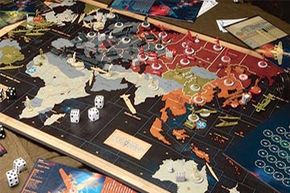Axis & Allies is a board game that allows the players to simulate the epic sweep of World War II, from Japan attacking Pearl Harbor to the Allied invasion of Normandy and the eventual defeat of the Axis nations of Germany, Italy and Japan. Since the players control the nations involved, the war can change in unexpected ways and play out a variety of scenarios. What if Japan captured Pearl Harbor and went on to attack the west coast of the U.S.? What if Britain had fallen under Germany's assault? What if Russia invaded Japan?
The game was originally designed by Larry Harris in the 1970s under the name "1942." A small game publisher released it in 1981, but it was the 1984 release by Milton Bradley that put Axis & Allies (named for the two opposing forces in World War II) on department store shelves and into the living rooms of families across the U.S. Since then, the game has been revised and re-released several times along with several variant versions -- all while changing ownership several times as well. It is currently published under the Avalon Hill imprint of game company Wizards of the Coast, which is owned by Hasbro.
Advertisement
Through all the changes, the core of the game has remained: Fight World War II on land, sea and air, gaining territory to improve your faction's economy, allowing you to purchase more troops and conquer more territory. Your ultimate goal is to capture certain key cities, ensuring global victory. Two to five players can play, with players on the same side working together to defeat the other side. It can be quite a challenge to coordinate attacks and troop movements among three different players controlling three different nations.
War games had been around for decades before Axis & Allies showed up, but the game was innovative in that it covered the entire war from a broad strategic standpoint. Also, most war games use small cardboard chits to represent units on the battlefield. Axis & Allies comes with a full complement of molded plastic miniature tanks, infantry soldiers, airplanes and battleships. The sheer visual appeal of the game went a long way toward making it so popular: In recent editions, the units are even unique to each nation, showing the actual aircraft and tanks used by the various armies.
This article will explain how to play Axis & Allies, discuss some of the rules revisions and detail some of the strategies you need to know to be successful the next time you sit down to win World War II.
Advertisement




